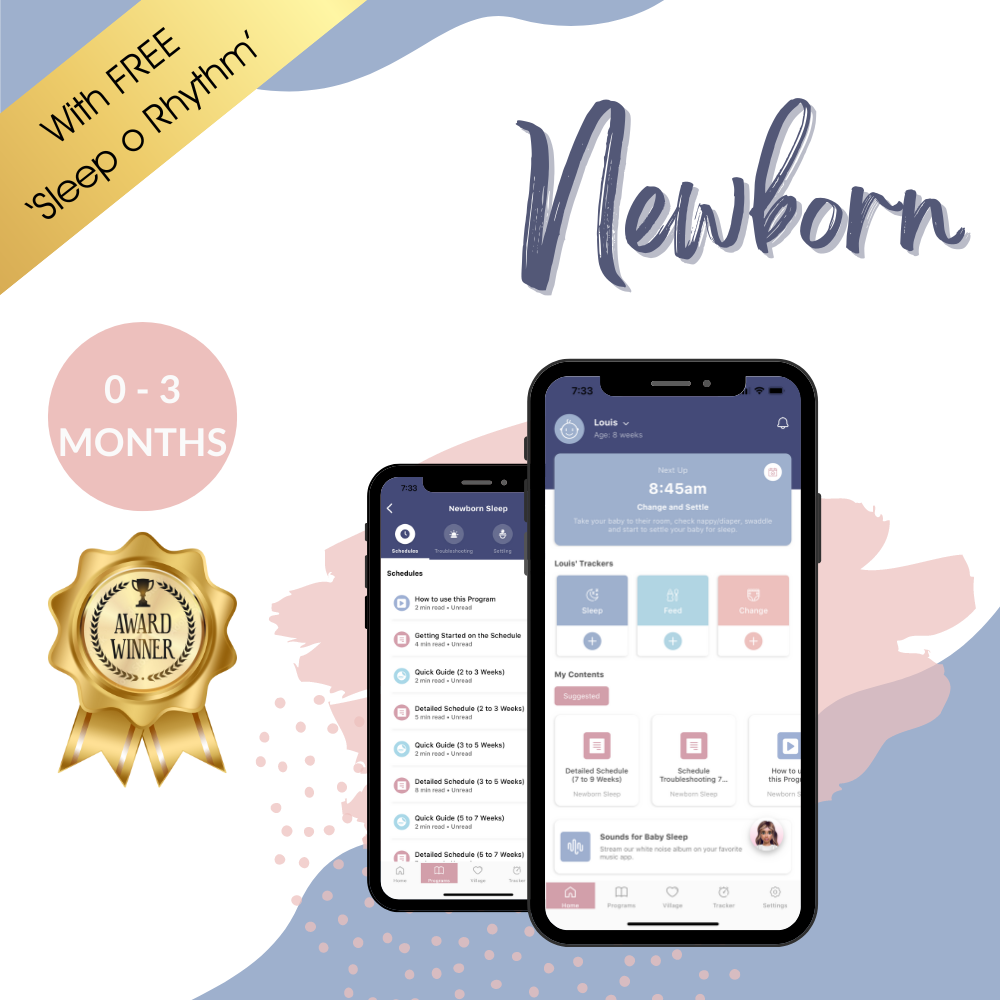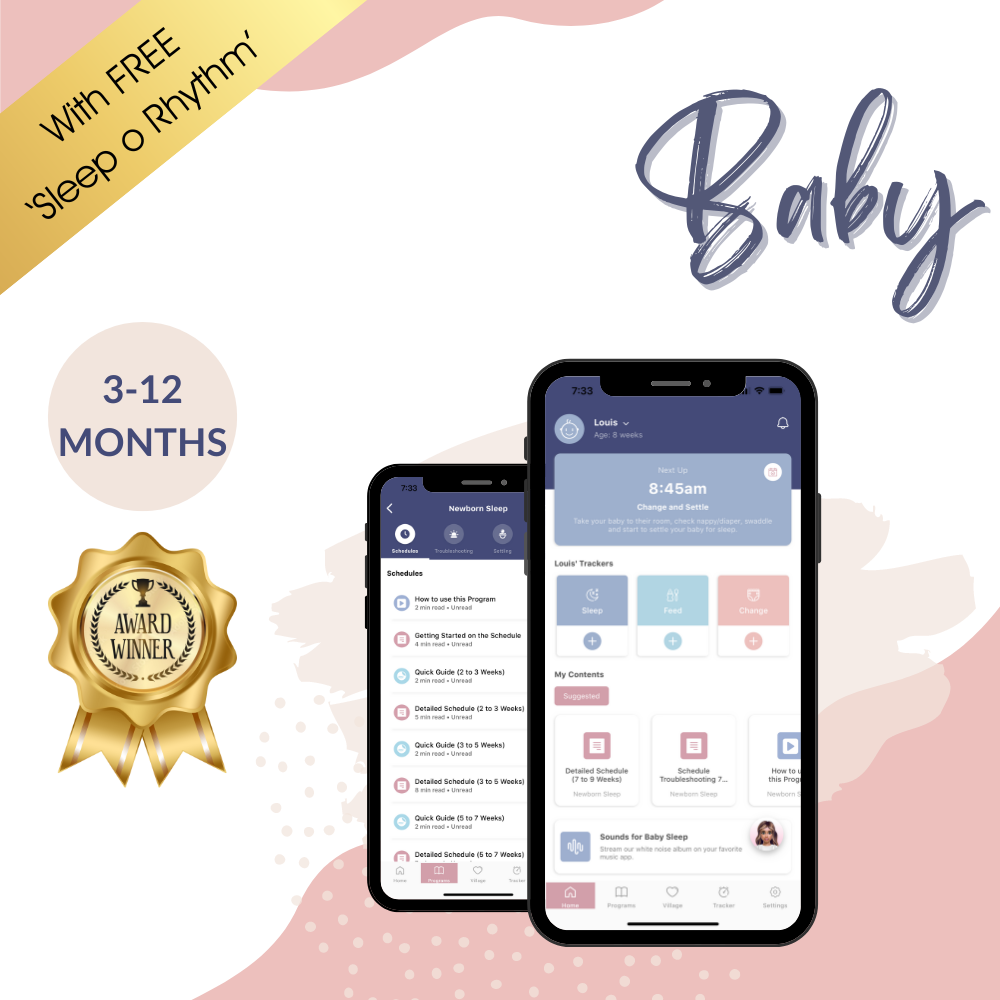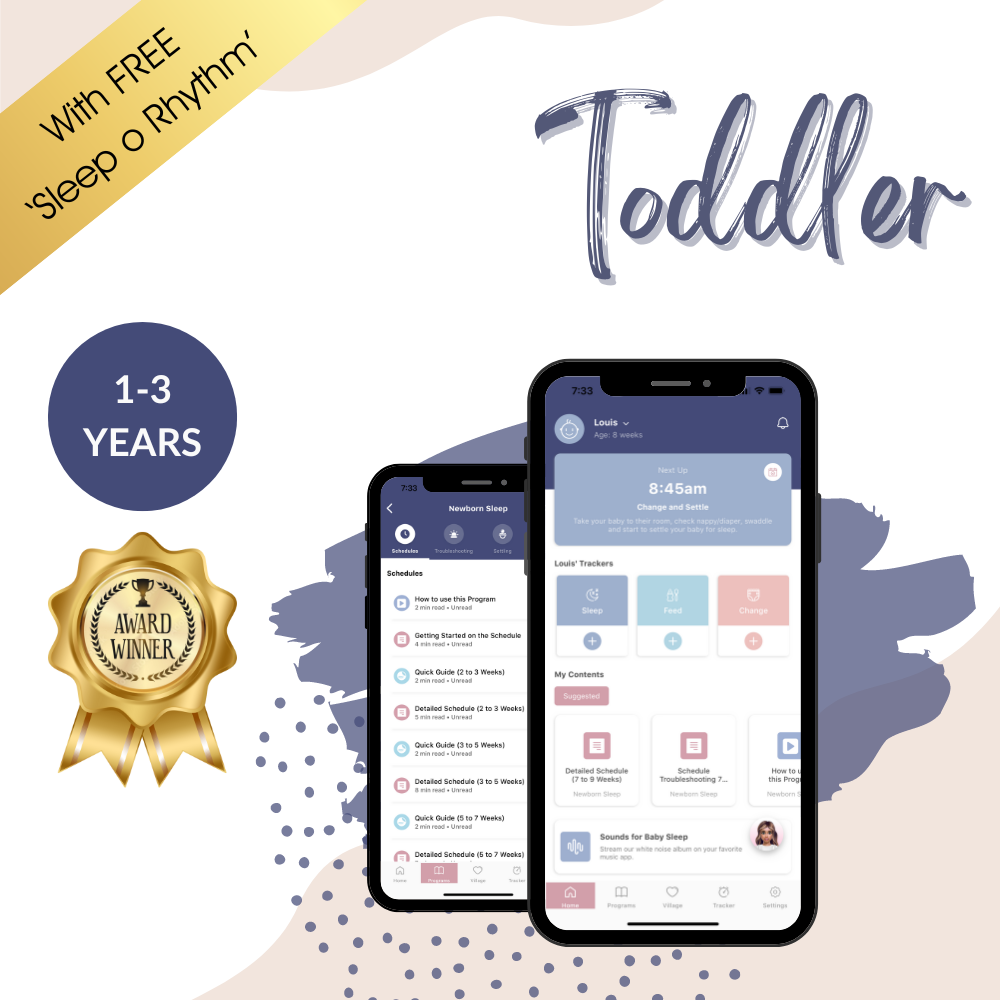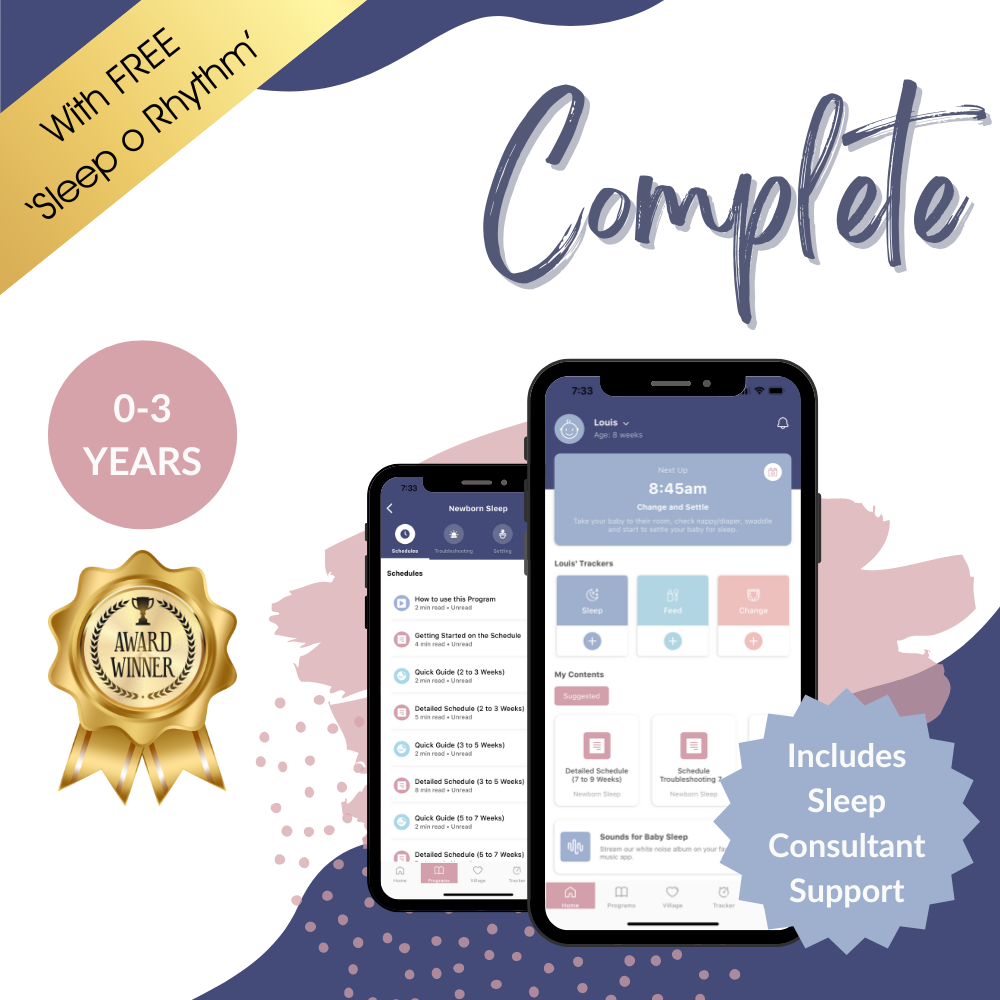
The ins and outs of bottle feeding
Bottle feeding has come a long way in a relatively short space of time. Before the Industrial Revolution if a baby wasn’t breastfeeding they would be offered milk by spoon or through a cow’s horn with a chamois to function as a teat!
Fast forward 250 odd years and now we are spoilt for choice with bottles, teats, formula and accessories.
Sometimes the options can feel overwhelming. It can be hard to know when you should be feeding your baby, how often or how much milk. Luckily our Little Ones App takes the guesswork out by giving you a daily nap and feed schedule based on your little one’s age.
In this article:
- Bottle feeding vs Breastfeeding
- Equipment
- Introducing a bottle
- How to bottle feed
- Weaning from breast to bottle
- What is pace feeding?
- Tips and Tricks
It's like having a sleep consultant in your pocket!
Help your family to sleep better with our Sleep Programs , trusted by medical professionals worldwide.
Get our Sleep Programs
Bottle feeding vs Breastfeeding
How you choose to feed your baby is a personal decision, however we understand that the subject of feeding can be very emotive for many.
The message that ‘breast is best’ can cause those who bottle feed to feel a range of emotions.
However figures from UNICEF show that most babies will be bottle fed at some point. This can be for a variety of reasons.
- Personal choice
- Medical reasons - for Mum or baby
- Lack of support
- Wanting a partner or family to be involved in feeding
- Returning to work or study
It is your choice to decide what is best for you and your baby. We support all parents and their choices, whether that is bottle, breast or combination feeding.
Equipment
When it comes to bottle feeding there are a few things you will definitely need...
Bottles
Plastic or glass, shape and size are all up to you, your budget and personal preference. Many parents find they try several different types of bottles until they find the one that best suits their baby.
So you may want to buy just one or two bottles of a brand before you commit and buy more.
Teats
Often these come in varying flow rates, again there are lots of different types to choose from.
Usually newborn babies are recommended to start with a slow flow teat. For breastfed babies it can take some trial and error to work out which flow is best to find the one that most closely mimics breastfeeding.
If you find your child is fussing on the bottle, taking much longer to finish a feed, falling asleep feeding or the teat is being sucked into the bottle then these would indicate they need to change teat size to allow a faster flow of milk.
Bottle brush
One of the biggest issues with bottle feeding is babies getting stomach bugs from unclean or unsterilised equipment. A bottle brush helps you to get into those awkward spots to make sure everything is spick and span.
Sterilising equipment
It is recommended to sterilise bottles and teats for at least the first 12 months to avoid infections.
There are different ways to sterilise bottles and teats. These are:
- Cold water steriliser solution
- Steam sterilising
- Boiling
- UV sterilising
Make sure that bottles and teats are washed in warm soapy water then rinsed before sterilising them.
There are many more accessories from bottle warmers, travel flasks, bottle making machines and much more but these are all up to you as a parent to decide what is necessary and what works best for you.
Introducing a Bottle
If you are breastfeeding then it is recommended to wait 4-6 weeks before introducing a bottle to ensure that breastfeeding is well established. This can help to avoid nipple confusion or babies then rejecting the breast.
Newborns have a strong suck reflex so if you would like to introduce a bottle try doing so in the first 12 weeks.
If you’re using formula milk for a bottle feed, choose a consistent time each day so that your body gets used to not needing to produce milk for that feed. It should take your body about a week to adjust to this.
If you’re using expressed breast milk then keep the time of the bottle feed the same time each day and after you have fed your baby then express breast milk for tomorrow’s bottle.
Say goodbye to sleepless nights.
Join over 800,000 families worldwide who are enjoying excellent sleep with our Sleep Programs, created by experts in the field of pediatric sleep.
Get our Sleep Programs
If you are feeding on demand (feeding when your baby lets you know they are hungry rather than feeding to a schedule), try choosing a feed for the bottle which is a fairly consistent time every day. This may be the bedtime feed or a dream feed if you do one.
How to Bottle Feed
It is recommended that you make up each feed one at a time as your baby needs them rather than making up feeds far in advance for your baby. This is because bacteria can multiply quickly and therefore it can increase the risk of your baby becoming unwell.
If you are using formula then always follow the manufacturer’s instructions for how to make up a feed.
If you are using expressed breastmilk be sure to follow guidelines for thawing and storing breastmilk. Most babies will prefer the milk to be warmed to body temperature, this is 37C. You can do this by running it under a warm tap or sitting the bottle or bag in a bowl of warm water.
Here's some more tips when bottle feeding your baby:
- Make sure you are sitting comfortably.
- Hold your baby close.
- Look at them and talk to them for day feeds, your voice gives them comfort.
- Hold them semi-upright and ensure their head is supported.
- Brush the teat against their lip or cheek. When they open their mouth wide, let them draw the teat in.
- Allow plenty of time for a feed and go at the baby’s pace.
- Keep the teat horizontal, just slightly tipped. This will ensure your baby isn’t swallowing lots of air and will keep the milk flow consistent.
- Offer frequent breaks to wind your baby.
- Never leave your baby alone with a bottle as they may choke.
- Be guided by your baby. Offer feeds when they show hunger cues. Don’t worry if they don’t finish a feed. Just like us, sometimes they will be hungrier on some day than others.
- Throw away any unfinished milk and wash the bottle straight away.
Weaning from Breast to Bottle
If you decide to wean from breastfeeding to bottle feeding (whether you are offering expressed breast milk or formula) try first introducing a bottle at a feed you know your little one will be hungry and sleepy as they are more likely to accept the bottle. The bedtime feed is a perfect feed for this, or if you do a dream feed this is a good time too.
Because breastfed babies have a stronger suck, try using a faster flow teat than is normally recommended for their age, or a variflow teat so they can regulate the milk flow themselves. If your baby is getting frustrated with the bottle it could be that the teat is flowing too slowly.
Try feeding the bottle in a different position than you'd normally breastfeed. A good alternative is putting a pillow on your knees and laying your baby on the pillow, facing you front-on, with their feet against your tummy. The difference in position means they're not associating the bottle feed with breastfeeding.
You may want to get someone else to do the feed, still using the above position.
Stay calm during your attempts. If you're getting frustrated and stressed your baby will pick up on this and may associate those feelings with the bottle.
Let's get your little one's sleep sorted ASAP!Our award-winning Sleep Programs will solve your baby's sleep challenges in no time.
Get our Sleep Programs
For a younger baby offer the bottle with minimal distractions, in a dim room and consider using white noise.
For an older baby, distract them. Let them look at something interesting like a mobile or an older sibling while you offer the bottle. Sometimes they'll drink without realising it as they are busy looking at what is going on.
Keep trying. You may not be successful straight away but being calm and consistent in your approach is key. If your baby is getting upset, stop for that day and try again at the same time the next day.
Once your baby is taking the bottle it is really important you offer it at the same time every day. They may start to refuse it again if you stop for a few days.
What is pace feeding?
Pace feeding basically means that the baby sets the pace of feeding. So rather than popping the bottle into your little one's mouth and feeding them until they have finished the bottle, you'll follow your baby's cues that they are hungry or full.
This method of bottle feeding can help to prevent over feeding and colic-type symptoms. It can also make it easier for babies to transition from breast to bottle feeding, as pace feeding is similar to how a baby would feed from the breast.
If you’re keen to try pace feeding here are some tips:
- Hold your baby in a more upright position, close to you.
- Keep the bottle horizontal, tipping it just enough to let the milk fill the teat.
- If your baby is drinking too fast then tip the bottle down or remove it. This will slow the pace of the feed and allow your baby more time to register if they are full.
- Don’t force your baby to finish a bottle if they show signs that they have had enough.
- Try switching sides half way through after winding your baby. This improves your baby's development of hand-eye coordination.
Tips and tricks
- Remain calm when introducing a bottle to your baby. This is a new skill for you both to learn, it will take time to get the hang of it. You will get there.
- Buy the essentials to start with. You can always buy more if you need it. Once you’ve got to grips with bottle feeding you’ll work out what else you need.
- Go at your baby’s pace. They won’t finish every bottle and that’s ok. Some bottles will be like a three-course meal and others will be like a small snack.
- Enjoy this time together, however you choose to feed your baby. It is a special bonding opportunity for you both.
- If you want to take the guesswork out of when to feed your baby have a look at our Little Ones App
------------
Bibliography
https://www.tommeetippee.com/en-us/parent-room/bottle-feeding-hints-and-tips
https://www.statista.com/statistics/938658/baby-feeding-bottle-market-forecast-worldwide/
https://www.unicef.org.uk/babyfriendly/about/breastfeeding-in-the-uk/
https://www.medela.co.uk/breastfeeding/mums-journey/storing-and-thawing-breast-milk
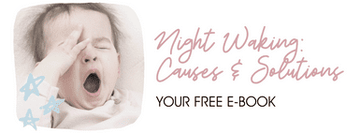
Receive product and services updates, promotional offers and other marketing communications based.


